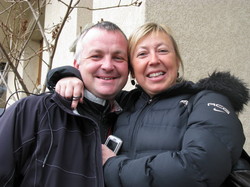The Sun Inn
Leave a Comment Excerpt from Eat Slow Britain by Alastair Sawday & Anna Colquhoun:
Excerpt from Eat Slow Britain by Alastair Sawday & Anna Colquhoun:
“People in Essex wanting good pasta or risotto come here,” says the Sun Inn’s proud Neapolitan chef, Ugo Simonelli. This fifteenth-century coaching inn may look quintessentially English, but the passion for good food and conviviality evoke an Italian trattoria. Owner Piers Baker says: “Sundays are mayhem: children dashing everywhere, parents reading the papers, grandparents nattering, and regulars at the bar laughing at us running around.” …
 Ugo exudes enthusiasm for Italian cuisine and, encouraged by adventurous diners, has unearthed vanishing dishes. Hare with chocolate and rosemary sauce is a relic of times when boundaries between sweet and savoury were blurred, and cassuola, a Milanese cabbage and pork stew, was traditionally eaten at the end of pig slaughtering season. Pumpkin and mussel soup, raw fish marinated with smoked Maldon salt and pan-fried lamb hearts have their fans too. For more conservative palates, there is grilled salt marsh lamb with roast beetroot, pan-fried calf’s liver with melted onions and sage, and sea bass with saffron potatoes and samphire.
Ugo exudes enthusiasm for Italian cuisine and, encouraged by adventurous diners, has unearthed vanishing dishes. Hare with chocolate and rosemary sauce is a relic of times when boundaries between sweet and savoury were blurred, and cassuola, a Milanese cabbage and pork stew, was traditionally eaten at the end of pig slaughtering season. Pumpkin and mussel soup, raw fish marinated with smoked Maldon salt and pan-fried lamb hearts have their fans too. For more conservative palates, there is grilled salt marsh lamb with roast beetroot, pan-fried calf’s liver with melted onions and sage, and sea bass with saffron potatoes and samphire.
Between shifts Ugo tends his vegetable patch or experiments with bresaola and prosciutto curing in the cellar. He also teaches in the village school. “We make pasta, pizza and gnocchi, and the kids find they like garlic, parmesan and basil after all. I had them eating pesto by the spoonful!” he laughs …









